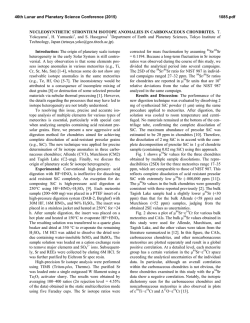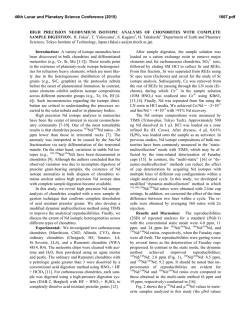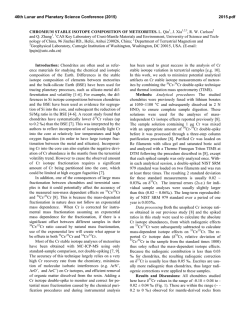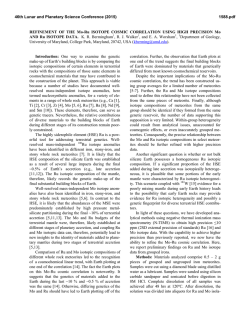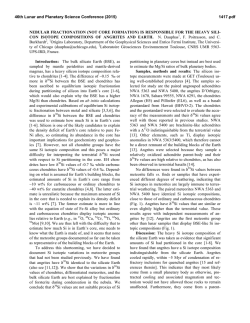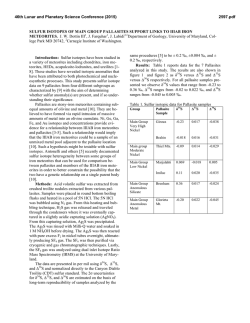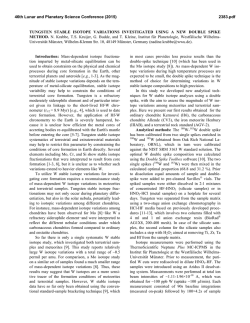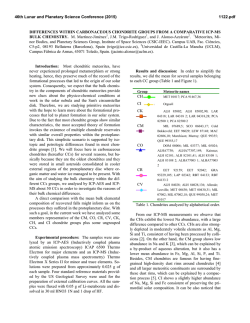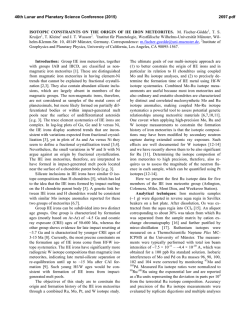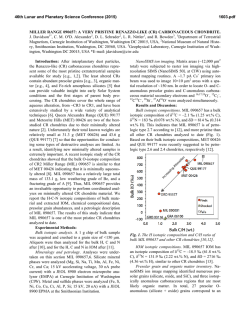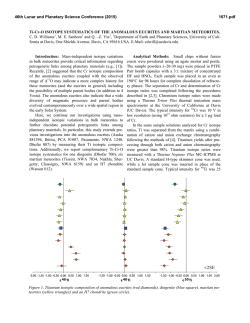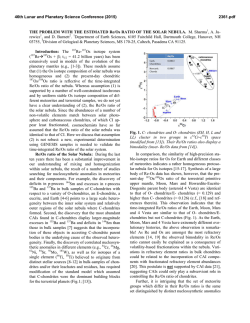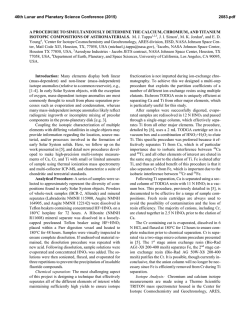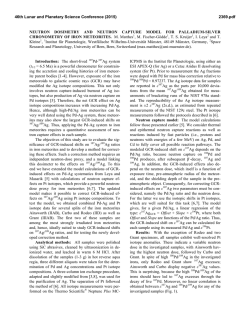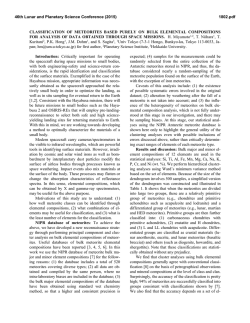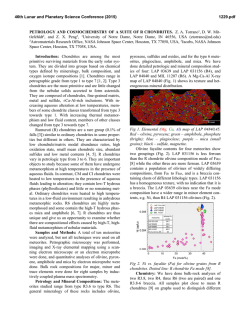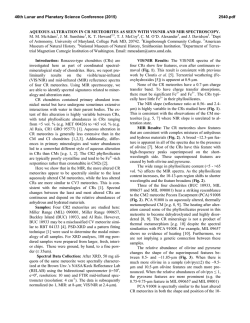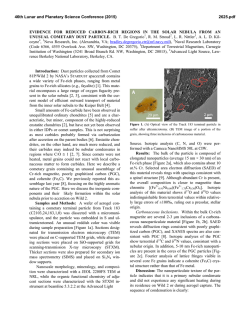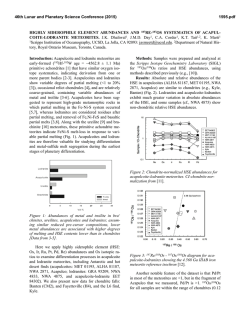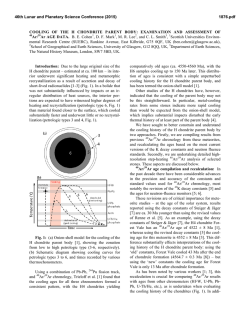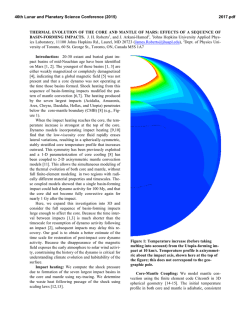
HIGH-PRECISION RUTHENIUM ISOTOPE MEASUREMENTS FOR
46th Lunar and Planetary Science Conference (2015) 2988.pdf HIGH-PRECISION RUTHENIUM ISOTOPE MEASUREMENTS FOR CONSTRAINING LATE ACCRETION. M. Fischer-Gödde1, C. Burkhardt2 and T. Kleine1. 1Institut für Planetologie, Westfälische Wilhelms-Universität Münster, Wilhelm-Klemm-Str. 10, 48149 Münster, Germany. Correspondence: [email protected], 2Origins Laboratory, Department of the Geophysical Sciences and Enrico Fermi Institute, The University of Chicago, IL 60637, USA. Introduction: Excess abundances of highly siderophile elements (Re, Os, Ir, Ru, Pt, Rh, Pd, Au) observed in the Earth’s mantle are commonly explained by the addition of a late veneer of primitive meteoritic material to the mantle after core formation was complete [1-3]. The composition of the late veneer has been inferred from the comparision of Os isotope compositions and relative HSE abundances in Earth's primitive mantle to those of chondritic meteorites [411]. However, while the 187Os/188Os ratio of the Earth’s primitive mantle overlaps with those of ordinary and enstatite chondrites, relative HSE abundances are inconsistent with a late veneer this composition. In particular the suprachondritic Ru/Ir of the primitive mantle cannot be accounted for by late accretion of known chondrites [e.g. 4,8]. The composition of the late veneer may also be assessed through the analysis of lunar impact melt rocks. These rocks bear testimony to the composition of bodies impacting the Earth and Moon since their formation about 4.4 Ga ago. Relative HSE abundances and 187 Os/188Os ratios of some lunar impact rocks reveal the presence of both chondritic and differentiated meteoritic impactor material [12-15]. On this basis it has been proposed that the HSE composition of the Earth's primitive mantle has been established by late accretion of predominantly carbonaceous chondrite material, mixed with a minor portion of differentiated iron meteorite-like material [15]. The fractionated iron meteorite-like component can account for the elevated Re/Os (and hence the observed 187Os/188Os), Ru/Ir and Pd/Ir of the Earth’s mantle in comparison to carbonaceous chondrites. More recently, the relative abundances of Se, Te and S have also been used to link the late veneer to a specific type of chondrite [16]. The chalcogen systematics suggest that the late veneer predominantly consists of carbonaceous chondrite-like material, consistent with the composition inferred from the lunar impact melt rocks. The Ru isotope compositions of meteorites and the Earth's mantle provide new constraints on the composition and origin of the late veneer. Because almost all meteorites are characterized by nucleosynthetic Ru isotope anomalies, caused by a deficit in s-process nuclides relative to terrestrial Ru [17,18], Ru isotopes are a sensitive tracer for the composition of the late veneer and to assess whether known meteorites can be the source of the late veneer. This is possible because almost the entire Ru in the Earth’s mantle derives from the late veneer, so that only meteorites (or a combination thereof) having a terrestrial Ru isotope composition can be source of the late veneer. Here we use high-precision Ru isotope measurements to constrain the origin of the late veneer by investigating a comprehensive set of meteorites with a special focus on those meteorite groups that are potential sources of the late veneer. Analytical techniques: Iron meteorite samples (~0.05-0.5g) were digested in reverse aqua regia in Savillex beakers on a hot plate. Analytical techniques for Ru separation and purification are provided in [20]. Chondrite powders (0.4-0.6 g) were digested in reverse aqua regia inside Carius tubes at 230 °C for 48 hours and purified using the same techniques as for the iron meteorites. Three Allende samples were dissolved using an alkaline fusion technique as described in [21]. Ruthenium from fluxed samples was purified by distillation in a PFA distillation unit. Ruthenium isotopes were measured on a ThermoScientific Neptune Plus MC-ICPMS at the University of Münster. The measurements were typically performed with total ion beam intensities of ~7.5 × 10-11 – ~4.4 × 10-10 A, obtained for a 100 ppb Ru standard solution. Isobaric interferences of Mo and Pd on Ru masses 96, 98, 100, 102 and 104 were corrected by monitoring 97Mo and 105Pd. Measured Ru isotope ratios were normalized to 99Ru/101Ru using the exponential law and are reported in εiRu units representing the deviation in parts per 104 from the terrestrial Ru isotope composition. Accuracy and precision of the Ru isotope measurements were evaluated by replicate digestions and multiple analyses of the NIST 129c steel doped with ~500 to ~2000 ng Ru from an Alfa Aesar standard solution. The external reproducibility (2 s.d.) of the Ru isotope analyses obtained for 49 individual measurements from 9 different digestions of NIST 129c over a period of the last two years is ±0.45 ε96Ru, ±0.51 ε98Ru, ±0.13 ε100Ru, ±0.14 ε102Ru, and ±0.35 ε104Ru. Results: Most meteorites and chondrites are characterized by well-resolved negative ε100Ru anomalies (Fig. 1). The IAB iron meteorites and EL enstatite chondrites are the only meteorites not showing clearly resolved Ru isotope anomalies, although the EL chondrites are probably also characterized by a small 100Ru 46th Lunar and Planetary Science Conference (2015) deficit. We are currently analyzing additional enstatite chondrites to assess whether their Ru isotope composition is different from that of the Earth's mantle. A prerequisite to utilize Ru isotope measurements for constraining the origin of the late veneer is that the true bulk Ru isotope composition of primitive chondrites is measured. However, many of these contain presolar grains, which are not easily dissolved using standard digestion technqiues. We have found that Allende samples digested in reverse aqua regia in Carius tubes display larger and more variable ε100Ru anomalies in comparison to Allende samples digested by alkaline fusion (Fig. 2). Obviously, Carius tube digestion is insufficient to dissolve all presolar components present in primitive chondrites, highlighting the importance of using a total digestion technique for Ru isotope studies. All chondrites investigated in the present study were either digested by alkaline fusion or are equilibrated samples devoid of presolar grains. 2988.pdf Fig. 2: ε100Ru data for replicate analyses of Allende using different digestion methods. Data for Carius tube digestions (blue circels, this study) and digestions in teflon vials on a hot plate (grey circles, [17]) display more scatter and larger isotope anomalies compared to data obtained for fused samples (red circles). Thus, the Ru isotope results, if substantiated by additional analyses of a more comprehensive suite of primitive carbonaceous and enstatite chondrites, suggest that the late veneer derives from a different population of bodies than known meteorites. One possibility is that the late veneer consists of the material remaining in the terrestrial planet region after the last giant impact occurred on Earth. This would be consistent with some recent dynamical models, in which volatilerich, carbonaceous chondrite-like material is transported into the inner solar system during the final stages of terrestrial planet accretion [22]. Fig. 1: ε100Ru data for iron meteorites and chondrites. Discussion: All meteorites investigated in the present study (except the IAB irons and possibly the enstatite chondrites) exhibit nucleosynthetic Ru isotope anomalies and, therefore, cannot be the source of the late veneer. Moreover, because all meteorites are characterized by a deficit in s-process Ru relative to the Earth’s mantle, a combination of different meteorites also does not result in the terrestrial Ru isotope composition. Therefore, neither the investigated carbonaceous chondrites nor a combination of carbonaceous chondrites with any of the investigated magmatic iron meteorites can represent the material added to the Earth’s mantle as a late veneer. Based on the Ru isotope results only the IAB irons and perhaps the EL chondrites are possible sources of the late veneer, but their chemical compositions do not match the HSE and chalcogen systematics of the Earth's mantle. References: [1] Chou C.-L. et al. (1978) Proc. Lun. Plan. Sci. Conf., 9, 219-230. [2] Morgan J. W. (1986) J. Geophys. Res., 91, 12,375-12,387. [3] O’Neill et al. (1991) GCA, 55, 1159-1172. [4] Becker H. et al. (2006) GCA, 70, 4528-4550. [5] Brandon A. D. et al. (2000) EPSL, 177, 319335. [6] Brandon A. D. et al. (2006) GCA, 70, 2093-2103. [7] Fischer-Gödde M. et al. (2010) GCA, 74, 356-379. [8] Fischer-Gödde M. et al. (2011) Chem. Geol., 280, 365-383. [9] Horan M. F. et al. (2003) Chem. Geol., 196, 5-20. [10] Meisel T. et al. (2001) GCA, 65, 1311-1323. [11] Walker R. J. et al. (2002) GCA, 66, 4187-4201. [12] Norman M. D. et al. (2002) EPSL, 202, 217-228. [13] Puchtel I. S. et al. (2008) GCA, 72, 3022-3042. [14] Sharp M. et al. (2014) GCA, 131, 62-80. [15] Fischer-Gödde M. and Becker H. (2012) GCA, 77, 135-156. [16] Wang Z. and Becker H. (2013) Nature, 499, 328-331. [17] Chen J. H. et al. (2010) GCA. 74, 38513862. [18] Fischer-Gödde M. et al. (2015) GCA, in Review. [19] Dauphas N. et al. (2004) EPSL, 226, 465–475. [20] Fischer-Gödde M. et al. (2015) LPS XLVI, this volume. [21] Morgan J. W. and Walker R. J. (1989) Anal. Chim. Acta, 222, 291-300. [22] Walsh K. J. et al. (2011) Nature, 475, 206-209.
© Copyright 2025
